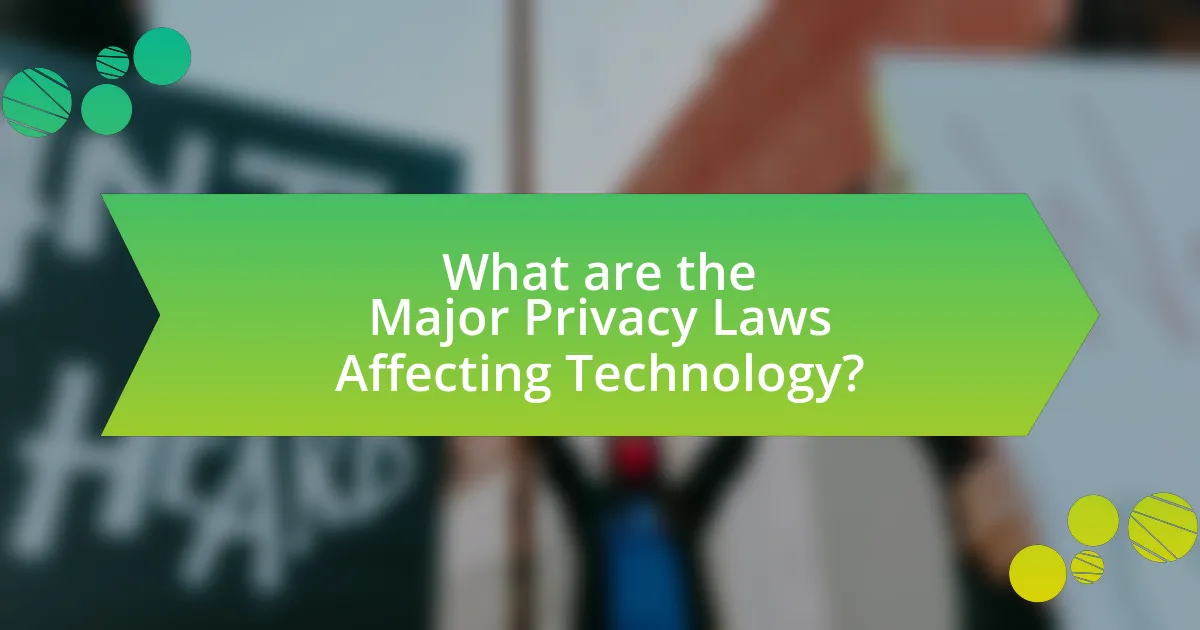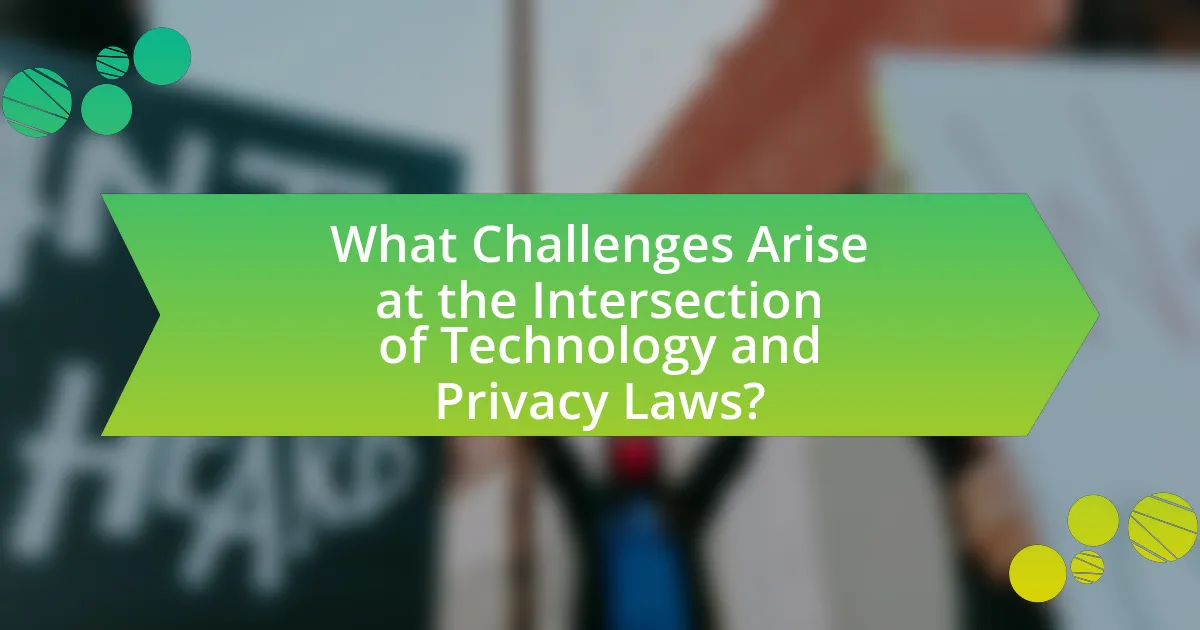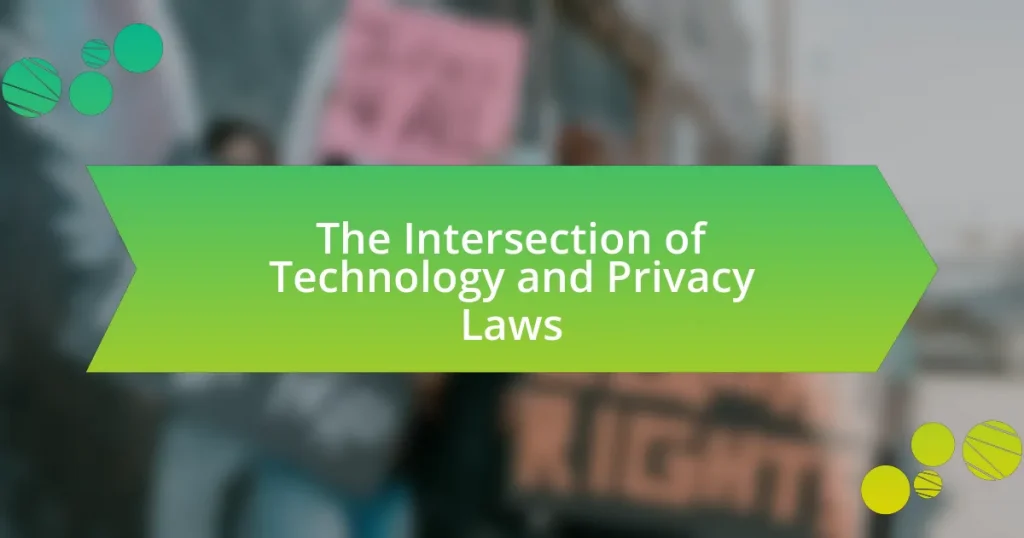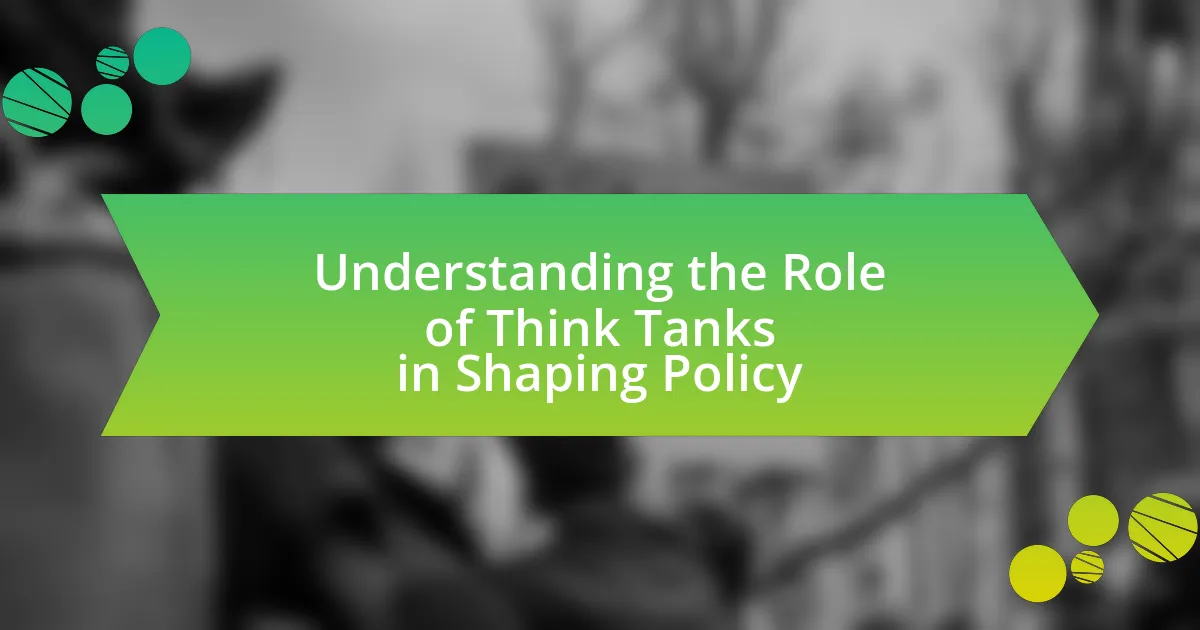The intersection of technology and privacy laws encompasses the regulatory framework governing the collection, storage, and use of personal data by technological entities. As advancements in technology, such as artificial intelligence and big data, raise privacy concerns, laws like the General Data Protection Regulation (GDPR) and the California Consumer Privacy Act (CCPA) have been established to protect individual privacy rights. This article explores how these laws interact with emerging technologies, the key regulations shaping privacy protection globally, and the challenges businesses face in compliance. It also discusses the implications of non-compliance, the role of employee training in privacy adherence, and best practices organizations can adopt to navigate this complex landscape effectively.

What is the Intersection of Technology and Privacy Laws?
The intersection of technology and privacy laws refers to the regulatory framework that governs how personal data is collected, stored, and used by technological entities. This intersection is increasingly significant as advancements in technology, such as artificial intelligence and big data analytics, raise concerns about individual privacy rights. For instance, the General Data Protection Regulation (GDPR) in the European Union establishes strict guidelines for data protection and privacy, impacting how companies utilize technology to handle personal information. Additionally, laws like the California Consumer Privacy Act (CCPA) provide consumers with rights regarding their data, reflecting the growing need for legal protections in the digital age. These regulations aim to balance innovation in technology with the safeguarding of personal privacy, ensuring that individuals have control over their own data.
How do technology and privacy laws interact in today’s digital landscape?
Technology and privacy laws interact in today’s digital landscape by establishing a framework that governs how personal data is collected, used, and protected. As technology advances, particularly with the rise of big data and artificial intelligence, privacy laws such as the General Data Protection Regulation (GDPR) in Europe and the California Consumer Privacy Act (CCPA) in the United States have been enacted to safeguard individual privacy rights. These laws require organizations to implement measures that ensure transparency, consent, and accountability in data handling practices. For instance, GDPR mandates that companies obtain explicit consent from users before processing their personal data, thereby influencing how technology companies design their data collection processes. This interaction is crucial as it shapes the development of technology while ensuring that individual privacy is respected and protected in an increasingly digital world.
What are the key technologies influencing privacy laws?
Key technologies influencing privacy laws include artificial intelligence, blockchain, and the Internet of Things (IoT). Artificial intelligence impacts privacy laws by enabling data analysis and profiling, raising concerns about consent and data usage. Blockchain technology enhances data security and transparency, prompting legal frameworks to address data ownership and access rights. The Internet of Things generates vast amounts of personal data, necessitating regulations to protect user privacy and ensure data protection compliance. These technologies collectively shape the evolving landscape of privacy legislation, as evidenced by the implementation of regulations like the General Data Protection Regulation (GDPR) in Europe, which addresses the challenges posed by these advancements.
How do privacy laws adapt to emerging technologies?
Privacy laws adapt to emerging technologies by evolving regulatory frameworks that address new challenges posed by advancements such as artificial intelligence, big data, and the Internet of Things. For instance, the General Data Protection Regulation (GDPR) in the European Union was implemented to enhance data protection and privacy in response to the digital economy’s growth, establishing principles like data minimization and user consent. Additionally, jurisdictions are increasingly incorporating provisions that require organizations to conduct impact assessments for technologies that process personal data, ensuring compliance with privacy standards. This adaptive approach is evident in the ongoing updates to privacy legislation, such as California’s Consumer Privacy Act (CCPA), which reflects the need for transparency and consumer control over personal information in a rapidly changing technological landscape.
Why is the intersection of technology and privacy laws important?
The intersection of technology and privacy laws is important because it ensures the protection of individuals’ personal data in an increasingly digital world. As technology advances, the volume of data collected and processed by companies grows, raising concerns about data breaches and misuse. For instance, the General Data Protection Regulation (GDPR) implemented in the European Union establishes strict guidelines for data protection, holding organizations accountable for safeguarding personal information. This legal framework not only empowers consumers with rights over their data but also compels businesses to adopt responsible data management practices, thereby fostering trust and accountability in the digital economy.
What risks do individuals face regarding privacy in technology?
Individuals face several risks regarding privacy in technology, including data breaches, surveillance, and unauthorized data collection. Data breaches expose personal information, with over 4.1 billion records compromised in 2019 alone, according to the Identity Theft Resource Center. Surveillance technologies, such as facial recognition, can lead to constant monitoring, eroding personal privacy. Additionally, many applications and services collect user data without explicit consent, often sharing it with third parties, which raises concerns about how that data is used and protected. These risks highlight the vulnerabilities individuals encounter in an increasingly digital world.
How do privacy laws protect consumers in a tech-driven world?
Privacy laws protect consumers in a tech-driven world by regulating how personal data is collected, used, and shared by companies. These laws, such as the General Data Protection Regulation (GDPR) in Europe and the California Consumer Privacy Act (CCPA) in the United States, grant consumers rights over their personal information, including the right to access, correct, and delete their data. For instance, GDPR mandates that companies obtain explicit consent from consumers before processing their data, ensuring that individuals have control over their personal information. Additionally, these laws impose penalties on organizations that fail to comply, thereby incentivizing businesses to prioritize consumer privacy and data security.

What are the Major Privacy Laws Affecting Technology?
The major privacy laws affecting technology include the General Data Protection Regulation (GDPR), the California Consumer Privacy Act (CCPA), and the Health Insurance Portability and Accountability Act (HIPAA). The GDPR, enacted in 2018, establishes strict guidelines for data protection and privacy for individuals within the European Union, imposing heavy fines for non-compliance. The CCPA, effective from 2020, grants California residents rights regarding their personal information, including the right to know what data is collected and the right to delete it. HIPAA, enacted in 1996, sets standards for the protection of health information, ensuring that personal health data is kept confidential and secure. These laws collectively shape how technology companies handle personal data, emphasizing user consent, transparency, and accountability.
What are the key privacy regulations globally?
The key privacy regulations globally include the General Data Protection Regulation (GDPR) in the European Union, the California Consumer Privacy Act (CCPA) in the United States, and the Personal Information Protection and Electronic Documents Act (PIPEDA) in Canada. GDPR, enacted in 2018, sets stringent guidelines for data protection and privacy for individuals within the EU and the European Economic Area, imposing heavy fines for non-compliance. CCPA, effective from January 2020, grants California residents rights regarding their personal information, including the right to know what data is collected and the right to delete it. PIPEDA, which came into force in 2000, governs how private sector organizations collect, use, and disclose personal information in the course of commercial activities in Canada. These regulations reflect a growing global emphasis on protecting individual privacy rights in the digital age.
How does the General Data Protection Regulation (GDPR) impact technology companies?
The General Data Protection Regulation (GDPR) significantly impacts technology companies by imposing strict data protection requirements and accountability measures. Technology companies must ensure compliance with GDPR mandates, such as obtaining explicit consent from users for data processing, implementing data protection by design and by default, and facilitating users’ rights to access, rectify, and erase their personal data. Non-compliance can result in substantial fines, reaching up to 4% of annual global turnover or €20 million, whichever is higher, as established by the regulation. This regulatory framework compels technology companies to adopt robust data governance practices, thereby influencing their operational strategies and business models.
What role does the California Consumer Privacy Act (CCPA) play in privacy protection?
The California Consumer Privacy Act (CCPA) plays a crucial role in privacy protection by granting California residents specific rights regarding their personal information. The CCPA empowers consumers to know what personal data is being collected, to whom it is being sold, and to request deletion of their data. Additionally, it mandates businesses to implement transparency measures and provides consumers with the right to opt-out of data sales. The act has set a precedent for privacy legislation, influencing other states and countries to consider similar protections, thereby enhancing overall consumer privacy rights.
How do these laws vary by region?
Privacy laws vary significantly by region, influenced by cultural, legal, and economic factors. For instance, the European Union enforces the General Data Protection Regulation (GDPR), which mandates strict data protection and privacy standards, emphasizing user consent and data minimization. In contrast, the United States adopts a more fragmented approach, with laws like the California Consumer Privacy Act (CCPA) providing state-specific regulations while lacking a comprehensive federal framework. Additionally, countries in Asia, such as Japan, have their own privacy laws, like the Act on the Protection of Personal Information (APPI), which aligns with international standards but also reflects local practices. These regional differences highlight the diverse approaches to balancing technology and privacy, shaped by each region’s unique legal landscape and societal values.
What are the differences between European and American privacy laws?
European privacy laws, primarily governed by the General Data Protection Regulation (GDPR), emphasize individual rights and data protection, while American privacy laws are more sector-specific and often prioritize business interests over individual privacy. The GDPR mandates explicit consent for data processing, grants individuals rights such as data access and erasure, and imposes strict penalties for non-compliance, reflecting a comprehensive approach to privacy. In contrast, the United States employs a patchwork of laws like the Health Insurance Portability and Accountability Act (HIPAA) for health data and the California Consumer Privacy Act (CCPA) for consumer data, which do not provide the same level of protection or uniformity as the GDPR. This fundamental difference highlights the European focus on privacy as a fundamental human right compared to the American model, which is more focused on economic considerations and less on individual privacy rights.
How do emerging markets approach privacy legislation?
Emerging markets typically approach privacy legislation by developing frameworks that balance economic growth with data protection. Countries like Brazil and India have enacted comprehensive data protection laws, such as the General Data Protection Law (LGPD) in Brazil and the Personal Data Protection Bill in India, which aim to safeguard personal data while fostering digital innovation. These laws often draw inspiration from established regulations like the European Union’s General Data Protection Regulation (GDPR), reflecting a trend towards more stringent privacy standards. Additionally, emerging markets face challenges such as limited enforcement capabilities and varying levels of public awareness regarding privacy rights, which can impact the effectiveness of these legislative measures.

What Challenges Arise at the Intersection of Technology and Privacy Laws?
Challenges at the intersection of technology and privacy laws include the rapid pace of technological advancement outstripping the development of legal frameworks, leading to regulatory gaps. For instance, the rise of artificial intelligence and big data analytics often results in the collection and processing of personal data without adequate consent or transparency, violating privacy rights. Additionally, differing privacy regulations across jurisdictions, such as the General Data Protection Regulation in Europe and the California Consumer Privacy Act in the United States, create compliance complexities for global companies. These challenges are compounded by the difficulty in enforcing privacy laws in a digital environment where data can be easily transferred across borders, making it hard to hold entities accountable for violations.
What are the main challenges for businesses in complying with privacy laws?
The main challenges for businesses in complying with privacy laws include understanding complex regulations, implementing adequate data protection measures, and managing consumer consent. Businesses often struggle with the intricacies of laws such as the General Data Protection Regulation (GDPR) and the California Consumer Privacy Act (CCPA), which require a deep understanding of legal language and obligations. Additionally, organizations must invest in technology and processes to secure personal data, which can be costly and resource-intensive. Managing consumer consent is also challenging, as businesses need to ensure that they obtain, document, and manage consent in a way that complies with legal requirements, while also maintaining customer trust. These challenges are compounded by the rapidly evolving nature of technology and data practices, making compliance a continuous effort rather than a one-time task.
How do companies balance innovation with privacy compliance?
Companies balance innovation with privacy compliance by integrating privacy-by-design principles into their product development processes. This approach ensures that privacy considerations are embedded from the outset, allowing for innovative solutions that also adhere to regulations like the General Data Protection Regulation (GDPR). For instance, organizations often conduct privacy impact assessments to identify potential risks and implement necessary safeguards, which can lead to innovative data protection technologies. Additionally, companies may leverage anonymization and encryption techniques to utilize data for innovation while minimizing privacy risks. This dual focus on compliance and innovation is supported by the fact that businesses that prioritize privacy can enhance customer trust, which is crucial for long-term success in a competitive market.
What are the consequences of non-compliance with privacy laws?
Non-compliance with privacy laws can result in significant legal and financial consequences for organizations. These consequences include hefty fines, which can reach millions of dollars, as seen in cases like the General Data Protection Regulation (GDPR) violations where penalties can be up to 4% of annual global turnover or €20 million, whichever is higher. Additionally, organizations may face lawsuits from affected individuals, leading to further financial liabilities and reputational damage. Regulatory bodies may also impose restrictions on business operations, including audits and increased scrutiny, which can disrupt normal business activities and lead to loss of customer trust.
How do technological advancements complicate privacy regulations?
Technological advancements complicate privacy regulations by introducing new data collection methods and increasing the volume of personal data generated. For instance, the rise of artificial intelligence and big data analytics allows companies to gather and analyze vast amounts of user information, often without explicit consent. This rapid evolution outpaces existing legal frameworks, making it challenging for regulators to enforce compliance. Additionally, technologies like blockchain and the Internet of Things create complex data ecosystems that blur the lines of data ownership and responsibility, further complicating regulatory efforts. As a result, privacy laws struggle to keep up with the pace of innovation, leading to gaps in protection for individuals.
What impact do artificial intelligence and big data have on privacy?
Artificial intelligence and big data significantly impact privacy by enabling extensive data collection, analysis, and profiling of individuals. These technologies facilitate the aggregation of personal information from various sources, often without explicit consent, leading to potential breaches of privacy rights. For instance, a study by the Electronic Frontier Foundation highlights that AI algorithms can infer sensitive information about individuals based on seemingly innocuous data, raising concerns about surveillance and data misuse. Furthermore, the Cambridge Analytica scandal exemplifies how big data can be exploited to manipulate personal information for political purposes, underscoring the urgent need for robust privacy regulations in the face of advancing technology.
How do cybersecurity threats challenge existing privacy laws?
Cybersecurity threats challenge existing privacy laws by exposing vulnerabilities in data protection frameworks, making it difficult for these laws to keep pace with rapidly evolving technological risks. For instance, data breaches can lead to unauthorized access to personal information, undermining the intent of privacy regulations like the General Data Protection Regulation (GDPR), which mandates strict data handling and protection measures. In 2020, the Identity Theft Resource Center reported a 68% increase in data breaches compared to the previous year, highlighting the inadequacy of current privacy laws to address the scale and sophistication of cyber threats. Consequently, existing privacy laws often lack the necessary provisions to effectively mitigate risks posed by advanced cyberattacks, leading to gaps in consumer protection and enforcement challenges.
What best practices can organizations adopt to navigate this intersection?
Organizations can adopt several best practices to navigate the intersection of technology and privacy laws effectively. First, they should implement comprehensive data governance frameworks that ensure compliance with relevant privacy regulations, such as the General Data Protection Regulation (GDPR) and the California Consumer Privacy Act (CCPA). These frameworks should include regular audits and assessments to identify and mitigate risks associated with data handling.
Additionally, organizations should invest in employee training programs focused on privacy awareness and data protection best practices. This training can help staff understand their responsibilities regarding personal data and the implications of non-compliance, thereby reducing the likelihood of breaches.
Furthermore, organizations should establish clear data processing agreements with third-party vendors to ensure that all parties adhere to the same privacy standards. This practice is crucial, as many data breaches occur due to inadequate protections in vendor relationships.
Lastly, organizations should leverage technology solutions, such as encryption and anonymization, to protect sensitive data. These technologies not only enhance security but also demonstrate a commitment to privacy, which can build trust with customers and stakeholders.
How can companies implement effective privacy policies?
Companies can implement effective privacy policies by conducting thorough data assessments, establishing clear data handling procedures, and ensuring compliance with relevant regulations. Conducting data assessments allows companies to identify what personal data they collect, how it is used, and where it is stored, which is essential for transparency. Establishing clear data handling procedures ensures that employees understand their responsibilities regarding data protection, thereby minimizing risks of breaches. Compliance with regulations such as the General Data Protection Regulation (GDPR) and the California Consumer Privacy Act (CCPA) is crucial, as these laws set specific requirements for data privacy that companies must follow to avoid legal penalties.
What role does employee training play in privacy compliance?
Employee training plays a crucial role in privacy compliance by ensuring that staff understand and adhere to data protection regulations. Effective training programs equip employees with knowledge about privacy laws, such as the General Data Protection Regulation (GDPR) and the California Consumer Privacy Act (CCPA), which are essential for safeguarding personal information. Research indicates that organizations with comprehensive privacy training experience fewer data breaches and compliance violations, highlighting the direct correlation between employee education and organizational security. For instance, a study by the Ponemon Institute found that organizations with a strong culture of privacy training had a 30% lower likelihood of experiencing a data breach. This underscores the importance of ongoing training in fostering a compliant and secure workplace.






